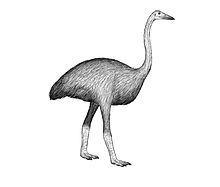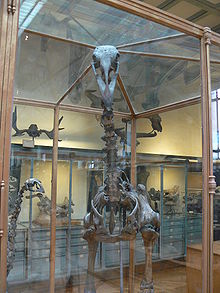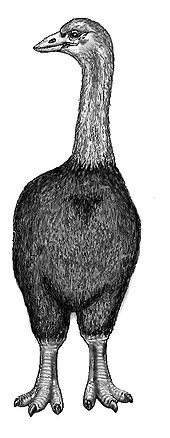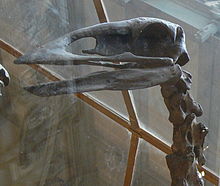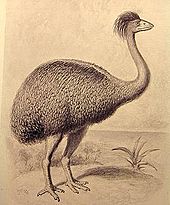
Elephant bird
About this schools Wikipedia selection
SOS Children made this Wikipedia selection alongside other schools resources. Visit the SOS Children website at http://www.soschildren.org/
| Elephant birds Temporal range: Quaternary–Recent |
|
|---|---|
 |
|
| Aepyornis maximus skeleton and egg | |
| Scientific classification |
|
| Kingdom: | Animalia |
| Phylum: | Chordata |
| Class: | Aves |
| Superorder: | Palaeognathae |
| Order: | †Aepyornithiformes Newton, 1884 |
| Family: | †Aepyornithidae Bonaparte, 1853 |
| Type species | |
| † Aepyornis maximus Hilaire, 1851 |
|
| Genera | |
|
|
| Diversity | |
| 2 genera, 7 species | |
Elephant birds are an extinct family of flightless birds found only on the island of Madagascar and comprising the genera Aepyornis and Mullerornis.
They are among the heaviest known birds ( Dromornis stirtoni of Australia reached a similar weight). The reasons for and timings of their extinctions remain unclear, although there are written accounts of elephant bird sightings on the island in the 17th century.
Description
The elephant birds, which were giant ratites native to Madagascar, have been extinct since at least the 17th century. Étienne de Flacourt, a French governor of Madagascar in the 1640s and 1650s, recorded frequent sightings of elephant birds. The famous explorer and traveler Marco Polo also mentions very large birds in his accounts of his journeys to the East during the 12th–13th centuries. These earlier accounts are today believed to describe elephant birds. Aepyornis was at the time the world's largest bird, believed to have been more than 3 m (10 ft) tall and weighing close to 400 kg (880 lb). Remains of Aepyornis adults and eggs have been found; in some cases the eggs have a circumference of more than 1 m (3 ft 3 in) and a length up to 34 cm (13 in). The egg volume is about 160 times greater than a chicken egg.
Species
Four species are usually accepted in the genus Aepyornis today; A. hildebrandti, A. gracilis, A. medius and A. maximus, but the validity of some is disputed, with numerous authors treating them all in just one species, A. maximus. Up to three species are also generally included in Mullerornis.
Genus Aepyornis
- Aepyornis gracilis ( Monnier, 1913)
- Aepyornis hildebrandti ( Burckhardt, 1893)
- Aepyornis mulleri ( Milne-Edwards & Grandidier, 1894)
- Aepyornis maximus ( Hilaire, 1851)
- Aepyornis modestus (Milne-Edwards & Grandidier, 1869)
- Aepyornis ingens (Milne-Edwards & Grandidier, 1894)
- Aepyornis titan ( Andrews, 1894)
- Aepyornis medius (Milne-Edwards & Grandidier, 1866)
- Aepyornis grandidieri ( Rowley, 1867)
- Aepyornis cursor (Milne-Edwards & Grandidier, 1894)
- Aepyornis lentus (Milne-Edwards & Grandidier, 1894)
Genus Mullerornis
- Mullerornis betsilei (Milne-Edwards & Grandidier, 1894)
- Mullerornis agilis (Milne-Edwards & Grandidier, 1894)
- Mullerornis rudis (Milne-Edwards & Grandidier, 1894)
- Flacourtia rudis (Andrews, 1894)
Food
Because there is no rainforest fossil record in Madagascar, it is not known for certain if there were species adapted to dense forest dwelling, like the cassowary in Australia and New Guinea today. However, some rainforest fruits with thick, highly sculptured endocarps, such as that of the currently undispersed and highly threatened forest coconut palm Voanioala gerardii, may have been adapted for passage through ratite guts, and the fruit of some palm species are indeed dark bluish purple (e.g. Ravenea louvelii and Satranala decussilvae), just like many cassowary-dispersed fruits.
Biogeography
Like the cassowary, ostrich, rhea, emu and kiwi, Mullerornis and Aepyornis were ratites; they could not fly, and their breast bones had no keel. Because Madagascar and Africa separated too long ago for the ratite lineage, Aepyornis had been thought to have dispersed and become flightless and gigantic in situ. A land bridge from elsewhere in Gondwana to Madagascar for the elephant bird-ostrich lineage was probably available around 85 million years ago. However, subfossil Aepyornis fragments have not yet been successfully sequenced for mitochondrial DNA. Some DNA has been extracted.
Supposed remains of "aepyornithid" eggs found on the eastern Canary Islands represent a major biogeographical enigma. These islands are not thought to have been connected to mainland Africa when elephant birds were alive. There is no indication that elephant birds evolved outside Madagascar, and today, the Canary Island eggshells are considered to belong to extinct North African birds that may or may not have been ratites ( Eremopezus/ Psammornis), or even Pelagornithidae, prehistoric seabirds of immense size.
Extinction
It is widely believed that the extinction of Aepyornis was a result of human activity. The birds were initially widespread, occurring from the northern to the southern tip of Madagascar. One theory states that humans hunted the elephant birds to extinction in a very short time for such a large landmass (the blitzkrieg hypothesis). There is indeed evidence that they were killed. Their eggs may have been particularly vulnerable. A recent archaeological study found remains of eggshells among the remains of human fires, suggesting that the eggs regularly provided meals for entire families.
The exact time period when they died out is also not certain; tales of these giant birds may have persisted for centuries in folk memory. There is archaeological evidence of Aepyornis from a radiocarbon-dated bone at 1880 ± 70 BP (approximately 120 CE) with signs of butchering, and on the basis of radiocarbon dating of shells, about 1000 BP (approximately 1000 CE).
An alternative theory is that the extinction was a secondary effect of human impact resulting from transfer of hyperdiseases from human commensals such as chickens and guineafowl. The bones of these domesticated fowl have been found in subfossil sites in the island (MacPhee and Marx, 1997: 188), such as Ambolisatra (Madagascar), where Mullerornis sp. and Aepyornis maximus have been reported. Also reported by these authors, ratite remains have been found in W-SW Madagascar, at Belo-sur-Mer (A. medius, Mullerornis rudis), Bemafandry (M. agilis) and Lamboharana (Mullerornis sp.).
Name
English name
Aepyornis maximus is commonly known as the 'elephant bird', a term that apparently originated from Marco Polo's account of the rukh in 1298, although he was apparently referring to an eagle-like bird strong enough to "seize an elephant with its talons". Sightings of eggs of elephant birds by early sailors (e.g. text on the Fra Mauro map of 1467-69, if not attributable to ostriches) could also have been erroneously attributed to a giant raptor from Madagascar. The legend of the roc could also have originated from sightings of such a giant subfossil eagle related to the African Crowned Eagle, which has been described in the genus Stephanoaetus from Madagascar, being large enough to carry off large primates; today, lemurs still retain a fear of aerial predators such as these. Another might be the perception of ratites retaining neotenic features and thus being mistaken for enormous chicks of a presumably more massive bird.
Malagasy name
The ancient Malagasy name for the bird is Vorompatra, meaning "bird of the Ampatres". The Ampatres are today known as the Androy region of southern Madagascar. Indeed, Étienne de Flacourt wrote (1658), "vouropatra - a large bird which haunts the Ampatres and lays eggs like the ostriches; so that the people of these places may not take it, it seeks the most lonely places".
Eggs
Occasionally subfossilized eggs are found intact. The National Geographic Society in Washington holds a specimen of an Aepyornis egg which was given to Luis Marden in 1967. The specimen is intact and contains the skeleton of the unborn bird. The Denver Museum of Nature and Science (Denver, Colorado) holds two intact eggs, one of which is currently on display. Another giant Aepyornis egg is on display at the Harvard Museum of Natural History in Cambridge, MA. A cast of the egg is preserved at the Grant Museum of Zoology at London University.
David Attenborough owns an almost complete eggshell, dating from 6-700 CE, which he pieced together from fragments that were given to him while making his 1961 BBC series Zoo Quest to Madagascar. In March 2011, the BBC aired the 60-minute documentary Attenborough and the Giant Egg, presented by Attenborough, about his personal scientific quest to discover the secrets of the elephant bird and its egg.
There is also an intact specimen of an elephant bird's egg (contrasted with the eggs from other bird species, including a hummingbird's) on display at the Delaware Museum of Natural History, just outside Wilmington, Delaware, USA, and another in the Natural History Museum, London, England.
The Melbourne Museum in Australia has two Aepyornis eggs. The first was acquired for £100 by Professor Frederick McCoy in June 1862, and is an intact example. In 1950 it was subjected to radiological examination, which revealed no traces of embryonic material. A second, side-blown Aepyornis egg was acquired at a later date.
In art and literature
- The Rukh is known from Sindbad the Sailor's encounter with one in " One Thousand and One Nights". Some scholars think the Roc is a distorted account of the Aepyornis. Historical evidence for this can be found in Megiser (1623).
- H.G. Wells wrote a short story entitled "Aepyornis Island" (1894) about the bird. It was first collected in The Stolen Bacillus and Other Incidents (1895).
- Wildlife artist Walton Ford created a painting called "Madagascar" about the Elephant Bird in 2002.

